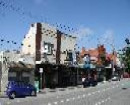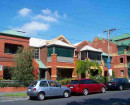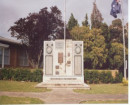Old Footscray Township Residential Area
Cowper, Bunbury, Hyde, Talbot and Whitehall Streets FOOTSCRAY, Maribyrnong City
-
Add to tour
You must log in to do that.
-
Share
-
Shortlist place
You must log in to do that.
- Download report






Statement of Significance
Statement of Significance
The Old Footscray Township Residential Precinct is significant to the City because:
- of the distinct building groups and other early fabric in the precinct express the development influences at play in Footscray from the beginning of permanent settlement in the region and the City, in particular the first river crossing and the two railway station locations, plus the resulting development surges ( Criteria A4, A3) ;
- the street pattern reflects the 1849 township plan and hence the early survey period (Criterion A4);
- it contains individually significant places such as early commercial structures such as one of the city's oldest hotels which catered for overland and river traffic before the dominance of other transport forms (Criterion A4); and
- the precinct contains the best examples of the rare mature street trees in the City (Bunbury St) which support the period expression of the built environment ( Criterion B2).
Australian Heritage Commission (AHC) criteria
The Australian Heritage Commission criteria consist of a set of eight criteria which cover social, aesthetic, scientific, and historic values. Each criterion has sub-criteria written specifically for cultural or natural values. The relevant criteria are:
A.3 richness and diversity of cultural features
A.4 demonstrates well the course and pattern of history, important historic events
B.2 rarity
-
-
Old Footscray Township Residential Area - Physical Description 1
The general character of the Old Footscray Township Residential Precinct is one of small Victorian & Edwardian single-storey attached and detached housing with brick and weatherboard wall cladding, corrugated iron and slate roofing, front verandahs, similar front and side setbacks and narrow block frontages. Properties originally had picket front fences and there was no provision for on-site vehicle parking for most of the identified housing. In the street there were originally asphalt footpaths and stone kerb and channel, with some surviving. The major built form was of the typical Victorian hipped roof and Edwardian hipped main roof and projecting gable roof form combination. Of the 94 places in the precinct as a whole 89 are contributory.
The housing is combined with remnants of an old commercial group in Whitehall Street with some two storey and masonry construction. Street construction includes early basalt kerb and channel, with asphalt used for footpaths, particularly in Bunbury and Cowper Streets. The mature street trees (ash, elm) in Bunbury St are the best group in the city. Underlying these physical attributes is the early grid township plan running parallel to the river.
The area's physical character underscores its development history. Edwardian timber housing prevails in Talbot and Bunbury Streets; Victorian and Edwardian houses mix in Hyde Street and the old commercial group survives in Whitehall Street, with some early commercial sites in Napier Street. Across this street are the Town Hall and other early civic sites which comprise a sub area of this early settlement.Old Footscray Township Residential Area - Physical Conditions
Physical Conditions: fair (disturbed, reasonably preserved)
Old Footscray Township Residential Area - Integrity
Integrity:partially intact/intrusions
Old Footscray Township Residential Area - Historical Australian Themes
Thematic context
Australian Principal Theme Making suburbs
PAHT Subtheme Making suburbs
Local Theme(s) River Crossings: Fords, Punts, Hotels and BridgesOld Footscray Township Residential Area - Physical Description 2
Map (Melway) 42 D5
Boundary description Parts of Talbot, Hyde, Cowper, Bunbury and Whitehall Streets, with emphasis on all original Edwardian-era and Victorian-era elements, including basalt pitched paving, asphalt footpaths, street trees, lot sizes and street patterns.
Heritage Significance City
Creation date(s) 1849-
Local Government Area City of Maribyrnong
Ownership Type Private & PublicHeritage Study and Grading
Maribyrnong - Maribyrnong Heritage Review
Author: Jill Barnard, Graeme Butler, Francine Gilfedder & Gary Vines
Year: 2000
Grading:
-
-
-
-
-
FOOTSCRAY RAILWAY STATION COMPLEX
 Victorian Heritage Register H1563
Victorian Heritage Register H1563 -
HENDERSON HOUSE
 Victorian Heritage Register H0183
Victorian Heritage Register H0183 -
ERCILDOUNE
 Victorian Heritage Register H0494
Victorian Heritage Register H0494
-
Archaeological site
 Southern Grampians Shire
Southern Grampians Shire -
Avoca
 Stonnington City H0809
Stonnington City H0809 -
BANYULE
 Victorian Heritage Register H0926
Victorian Heritage Register H0926
-
-











